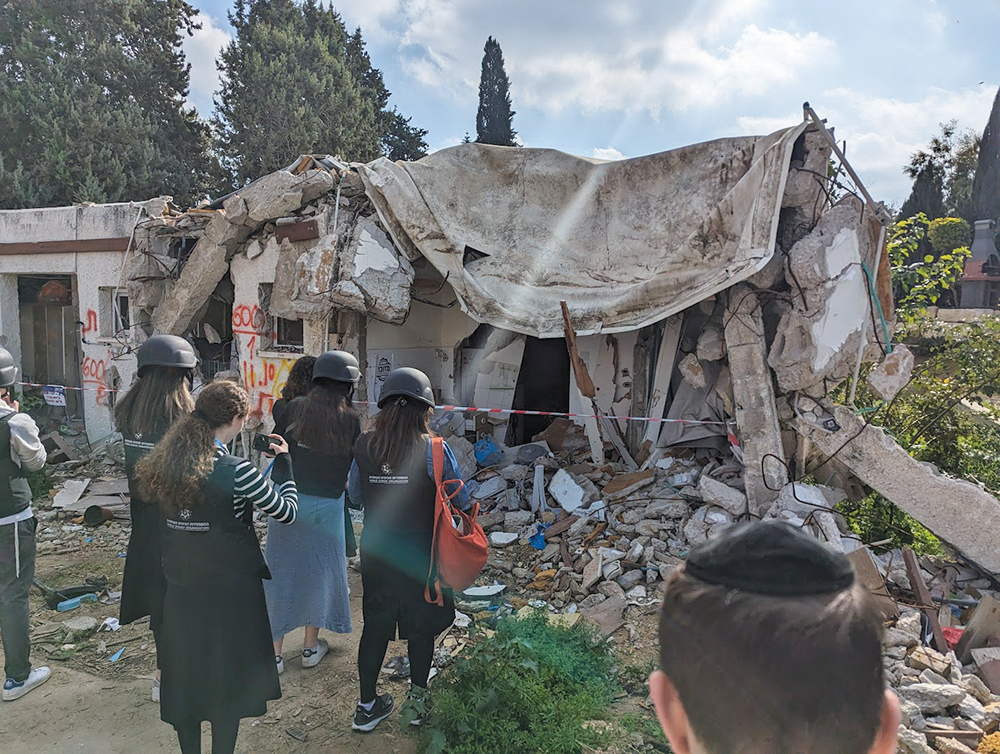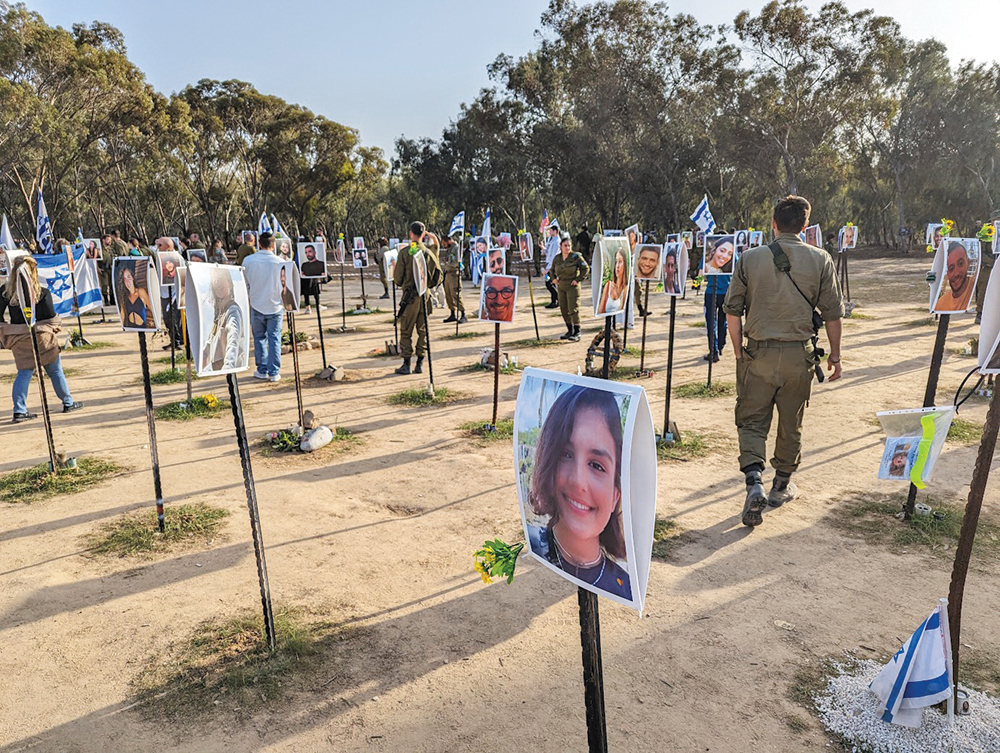
In a volunteer mission showcasing Yeshiva University’s solidarity with Israel, 37 students and four faculty members spent January 7–14 touring the country, bearing witness to the pain, the courage, the chesed, and fortitude of our nation. The mission was hosted by YU’s Sacks-Herenstein Center and its founders, Terri and Andrew Herenstein, and funded in part by Elliot Gibber—YU Trustee—and family.
At the airport, each participant received a book of study resources to heighten the meaning of each day as well as Rabbi Jonathan Sacks’ book “To Heal A Fractured World.” The group also raised money to outfit the IDF’s 727th all-women’s combat brigade serving in Gaza for the winter and arrived with 24 duffle bags of requested supplies. Each of us immediately felt the impact of the war as we walked the long Ben Gurion corridor lined with hostage photos, and the appearance of a single hostage on a screen when walking through passport control. Our first stop was the Kotel.
We had a packed schedule, and each day — which began with tefillah and talmud Torah — included a range of moving and inspiring experiences. We spent the first morning at the urban farm, Ohr Layerek, picking over 3,000 pounds of beets, since most farmers are currently on reserve duty. We then headed to Carmei Gat to run a carnival for children whose fathers are at war and to help run art workshops for reservist wives. An officer serving in the Otef (Gaza Envelope), and his wife, who has been solo parenting for over 80 days, spoke to us about the pressures of war on families since the war’s beginning. We ended the day with a lecture by Gil Hoffman, the executive director of Honest Reporting, which targets anti-Israel bias in the media, and an address by President Ari Berman, who spoke about his own son serving in the IDF and the importance of personal service demanded of us at this time.
The most difficult day of the trip was going down south to many communities in the Gaza Envelope and witnessing firsthand the Hamas atrocities of October 7. In bulletproof vests and helmets, we walked through the ruins of Kfar Aza; burnt homes with IDF spray paint on exterior walls indicated which houses were checked by the IDF and how many people lost lives within that home. Of the population of 765, 63 were killed, 18 were taken hostage and four were injured.

We also heard from the head of security from Kisufim, a smaller southern kibbutz, which was directly targeted by Hamas. We stopped to see the pile of over 1,500 burned automobiles from that fateful day, and went to the Nova Festival site, bringing together soldiers, police officers and others, and paid homage with a group Kaddish and Hatikva. We stopped at the Yeshiva of Sderot, visited the site of the police station occupied by 26 terrorists on October 7, and received a blessing from Rav Asher Weiss, who was teaching at the yeshiva that afternoon.
In the evening, we volunteered at Tzomet Gilat, a stop near Netivot for soldiers on break from Gaza to eat and relax, and then joined Grilling4theIDF with the YU basketball team to run a barbeque for soldiers.
One morning, we joined YU’s Straus scholars to hear from Rabbi Yosef Tzvi Rimon, Rabbi Meir Soloveitchik and Natan Sharansky on the war. We then traveled to Hebrew University’s Givat Ram campus to volunteer with Malachei Ariel, a program designed to provide after-school activities to the children from evacuated families in Jerusalem. We also paid a shiva visit to the parents of Gavriel Bloom, hy”d, a soldier from Beit Shemesh who was killed on active duty. His father is a Sy Syms graduate. Our day in the Tel Aviv area included a visit to Hostage Square and a conversation with the sister of a survivor from Kibbutz Be’eri. Rabbi Doron Perez, head of World Mizrahi, shared his pain and struggle having one son, Yonatan, who was shot in battle, and whose other son, Daniel, was taken hostage. We went to Magen David Adom’s Blood Center and learned about MDA’s important work during this war.
Undoubtedly, the centerpiece of the trip was a new Torah dedication in Ofakim sponsored by the Herenstein family and organized by Shai Graucher to honor the memory of two brothers, Ariel and Roi Guri, who were killed by terrorists as they tried to defend the city. Students were invited to write a letter in the scroll and then, upon the Torah’s completion, danced the Torah to the site where each brother was killed, and then danced it in the streets to their yeshiva. It was the Simchat Torah that Ofakim never had.
We also met with Dr. Ilana Engel, a dentist who heads up a forensic team that identifies bodies through dentistry, and Dr. Yardeana Osband, a Stern College graduate now living in Israel, who began a nonprofit in her backyard after the war started. Deputy-Mayor of Jerusalem Fleur Hassan-Nahoum addressed us about Israel advocacy through social media and how to combat potentially aggressive, antisemitic confrontations.
Shabbat was hosted by Susan Sheldon from YU’s Israel office and her husband Jeremy, and we heard from Mr. Alan Sacks, Rabbi Sacks’ brother. After Shabbat, we enjoyed a melave malke at the Herenstein’s home with Ishay Ribo in a private concert. His music spoke to the soul after a very emotionally, spiritually and intellectually complex week.
Our final destination was Achim L’chaim, Brothers for Life, a nonprofit and respite facility for injured soldiers that connects those recently wounded with veteran soldiers who suffered from the same injury years earlier as friends for life. We heard from Raz, an Israeli soldier from the army’s Oketz unit, which uses dogs to sniff out explosives. He spoke about being shot in Gaza years earlier and suffering from PTSD. He helped us appreciate the very long road to rehabilitation and healing and those who supported him along the way.
In To Heal a Fractured Word, Rabbi Sacks wrote: “God’s first question to humankind was, ‘Where are you?’ (Gen. 3:9). That is the question heard by those who have internalized the ethic of responsibility.” This trip helped us internalize the obligations that we must all take on as a result of this war. We saw, we heard, we acted, and now we must bear witness and lead.
By Dr. Erica Brown (Vice Provost/Director Sacks-Herenstein Center) and Jonathan Wenger (Yeshiva College ’24, Comp Sci)












